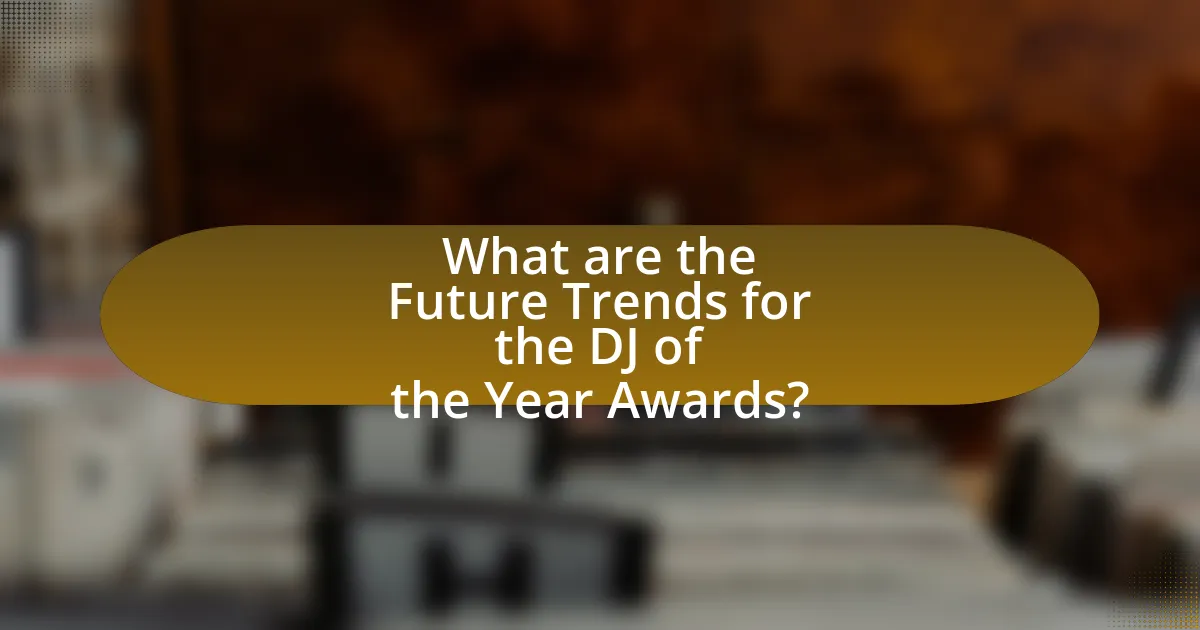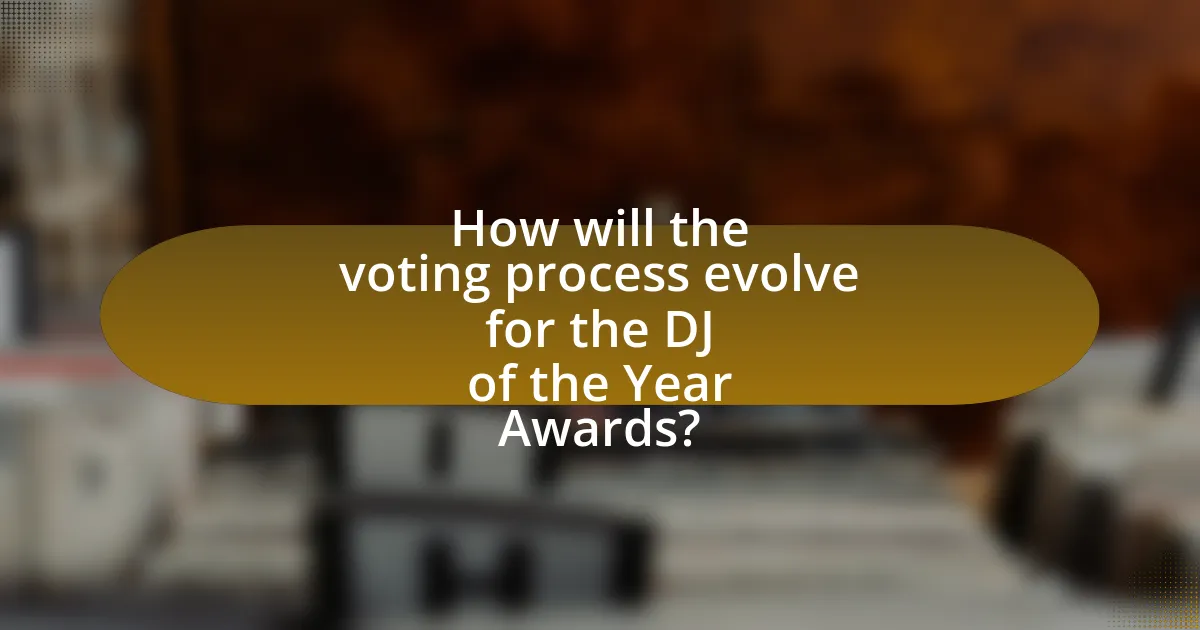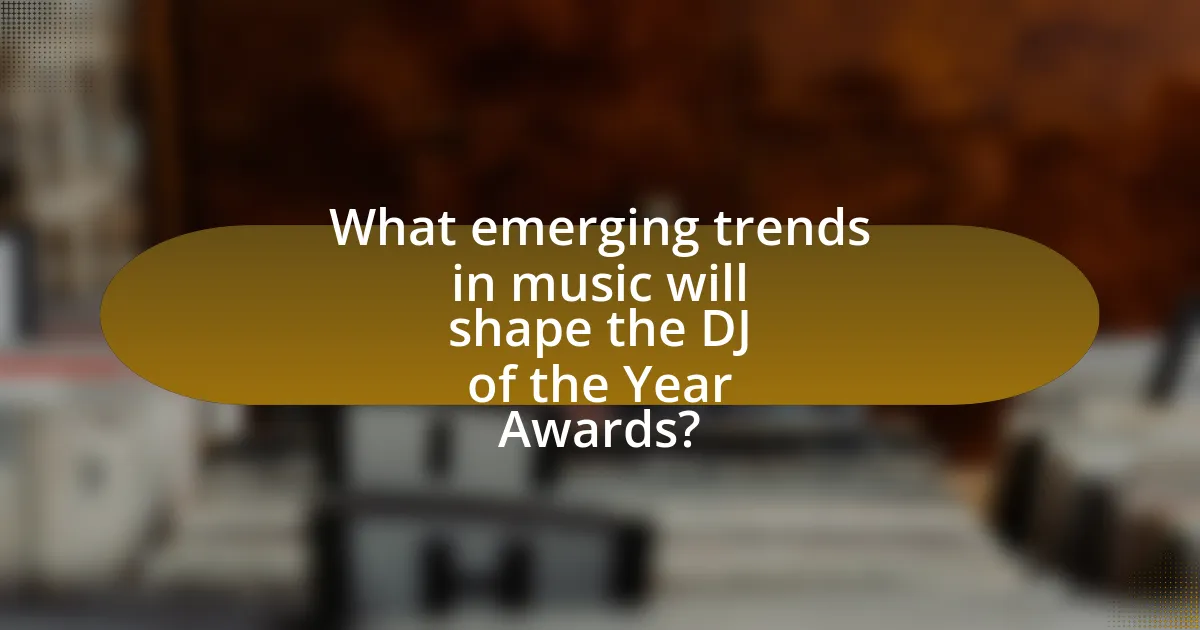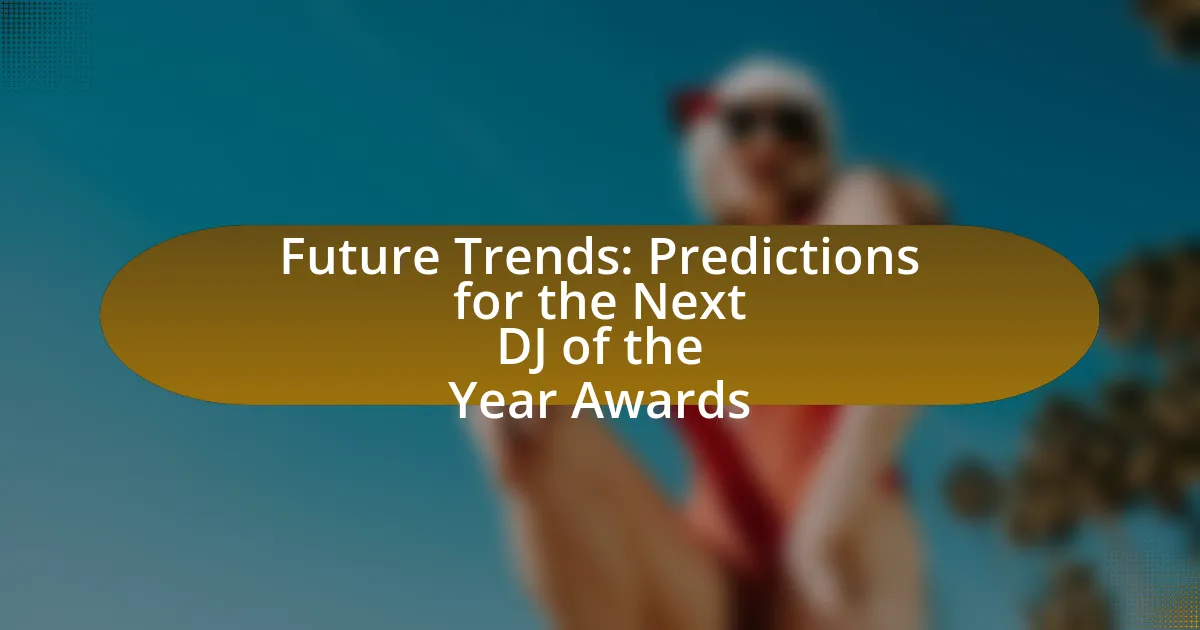The article focuses on the future trends for the DJ of the Year Awards, highlighting the increasing integration of technology and audience engagement in the evaluation process. It discusses how data-driven metrics, such as streaming statistics and social media influence, will play a crucial role in assessing nominees, alongside the growing recognition of diverse music genres. The article also examines the impact of past trends on award criteria, the evolution of voting processes through technological advancements, and the significance of social media in shaping public perception and engagement. Additionally, it explores how emerging music genres and collaborations between DJs and artists will influence nominations and award outcomes.

What are the Future Trends for the DJ of the Year Awards?
The future trends for the DJ of the Year Awards indicate a growing emphasis on technology integration and audience engagement. As the music industry evolves, awards are likely to incorporate more data-driven metrics, such as streaming statistics and social media influence, to assess nominees. For instance, the rise of platforms like Spotify and TikTok has already shifted how artists gain recognition, suggesting that future awards will reflect these changes by prioritizing digital presence and fan interaction. Additionally, the inclusion of diverse genres and styles is expected to expand, recognizing the global influence of various music cultures. This trend aligns with the increasing popularity of cross-genre collaborations and the blending of traditional and electronic music, which has been evident in recent award nominations and winners.
How have past trends influenced the DJ of the Year Awards?
Past trends have significantly shaped the DJ of the Year Awards by establishing criteria for evaluation and recognition within the industry. For instance, the rise of electronic dance music (EDM) in the 2010s led to increased visibility for DJs, influencing award categories to reflect this genre’s popularity. Additionally, the incorporation of social media metrics, such as follower counts and engagement rates, has become a standard in assessing nominees, driven by trends in digital marketing and fan interaction. Historical data shows that the winners often align with prevailing musical styles and technological advancements, such as the use of live streaming and innovative production techniques, which have become essential in recent years.
What patterns can be observed in previous award winners?
Previous award winners often exhibit a trend of consistent innovation and genre versatility. Many successful DJs have demonstrated the ability to blend various musical styles, appealing to a broader audience. For instance, winners frequently incorporate elements from electronic dance music, hip-hop, and pop, showcasing their adaptability. Additionally, a significant number of past recipients have built strong social media presences, leveraging platforms to engage with fans and promote their work. This engagement often correlates with increased visibility and popularity, as seen in the rise of artists like Calvin Harris and Tiësto, who have effectively utilized social media to enhance their careers. Furthermore, award winners tend to have a history of high-profile collaborations, which not only elevate their status but also expand their reach within the music industry.
How have technological advancements shaped the awards over the years?
Technological advancements have significantly shaped awards by enhancing the voting process, improving audience engagement, and expanding the reach of ceremonies. For instance, the introduction of online voting systems has made it easier for fans to participate, increasing voter turnout and inclusivity. Additionally, live streaming technology has allowed awards ceremonies to reach global audiences, as seen with events like the Grammy Awards, which have utilized platforms like YouTube to broadcast to millions. Furthermore, social media integration has enabled real-time interaction and promotion, amplifying the visibility of nominees and winners. These advancements have transformed how awards are conducted and experienced, making them more accessible and engaging for a broader audience.
What factors will impact the next DJ of the Year Awards?
The next DJ of the Year Awards will be impacted by factors such as social media presence, streaming statistics, and live performance quality. Social media engagement, particularly on platforms like Instagram and TikTok, has become crucial for DJs to connect with fans and promote their work, influencing public perception and voting. Streaming statistics from platforms like Spotify and Apple Music serve as measurable indicators of a DJ’s popularity and reach, directly affecting their chances of winning. Additionally, the quality of live performances, including set creativity and audience engagement, plays a significant role in establishing a DJ’s reputation and can sway both public votes and industry recognition.
How will changes in music genres affect the nominations?
Changes in music genres will significantly affect nominations by altering the criteria and preferences of voting bodies. As new genres emerge and gain popularity, such as electronic dance music or hip-hop, they can shift the focus of awards towards artists who represent these styles. For instance, the rise of streaming platforms has led to a surge in genre-blending music, which has been recognized in recent nominations, reflecting a broader acceptance of diverse sounds. Historical data shows that the Grammy Awards have adapted their categories to include more contemporary genres, indicating that shifts in musical trends directly influence nomination processes.
What role does social media play in the selection process?
Social media significantly influences the selection process for awards like DJ of the Year by shaping public perception and engagement. Platforms such as Instagram, Twitter, and Facebook allow fans to express their preferences, which can sway voting outcomes. For instance, a study by the Pew Research Center found that 69% of adults in the U.S. use social media, indicating its broad reach and impact on audience opinions. Additionally, social media campaigns can amplify an artist’s visibility, leading to increased support and votes during the selection process. This demonstrates that social media is not just a communication tool but a critical factor in determining award winners.

How will the voting process evolve for the DJ of the Year Awards?
The voting process for the DJ of the Year Awards will evolve by incorporating advanced technology and increased audience engagement. Future iterations are likely to utilize blockchain technology to ensure transparency and security in the voting process, as seen in other award shows that have adopted similar systems. Additionally, social media platforms may play a more significant role, allowing fans to vote in real-time and increasing participation rates. This evolution aligns with trends in digital engagement, where interactive voting mechanisms have shown to enhance audience involvement, as evidenced by the success of platforms like Twitter and Instagram in facilitating fan-driven polls.
What changes can we expect in voter demographics?
Voter demographics are expected to shift significantly due to increasing diversity and changing age distributions. Specifically, younger voters, particularly those aged 18-29, are becoming a larger portion of the electorate, driven by higher engagement in social issues and technology use. According to the U.S. Census Bureau, the percentage of eligible voters aged 18-29 increased from 50% in 2016 to 53% in 2020, indicating a trend towards greater participation among younger demographics. Additionally, the growing multicultural population in the United States, with Hispanic and Asian voters projected to represent a larger share of the electorate, will further influence voting patterns and preferences in upcoming elections.
How will the inclusion of global audiences influence the awards?
The inclusion of global audiences will significantly influence the awards by broadening the voting base and enhancing the diversity of nominees. This expanded participation allows for a more representative selection of artists, reflecting various musical styles and cultural influences from around the world. For instance, the rise of digital platforms has enabled international fans to engage in voting processes, as seen in the global reach of awards like the Grammy Awards, which have increasingly recognized artists from diverse backgrounds. This trend not only increases the legitimacy of the awards but also encourages artists to innovate and appeal to a wider audience, ultimately shaping the future landscape of the DJ industry.
What new voting technologies might be implemented?
New voting technologies that might be implemented include blockchain-based voting systems, which enhance security and transparency, and mobile voting applications that facilitate accessibility for voters. Blockchain technology, utilized in various elections globally, ensures that votes are securely recorded and immutable, reducing the risk of fraud. Mobile voting applications, already tested in some jurisdictions, allow voters to cast their ballots remotely, increasing participation rates. These technologies are being explored to modernize the voting process and improve voter engagement in future awards like the DJ of the Year Awards.
How will transparency in the voting process be enhanced?
Transparency in the voting process will be enhanced through the implementation of blockchain technology, which provides a secure and immutable record of votes. This technology allows for real-time tracking of votes, ensuring that each vote is verifiable and cannot be altered after submission. Additionally, public access to the voting records will be facilitated, enabling independent audits and increasing trust among participants. Studies have shown that blockchain can reduce fraud and increase voter confidence, as evidenced by its successful use in various elections worldwide, such as the 2020 Utah Republican Party primary, where it was employed to enhance transparency and security.
What measures can be taken to ensure fair representation?
To ensure fair representation in the DJ of the Year Awards, implementing a diverse selection committee is essential. A diverse committee can include members from various backgrounds, genres, and demographics, which helps to mitigate biases and broaden perspectives in the selection process. Research indicates that diverse teams make better decisions, as they incorporate a wider range of viewpoints and experiences (Page, S.E., “The Difference: How the Power of Diversity Creates Better Groups, Firms, Schools, and Societies,” 2007). Additionally, establishing transparent criteria for nominations and voting can enhance accountability and trust in the process. By publicly sharing the selection criteria and ensuring that they are applied consistently, stakeholders can better understand how decisions are made, which fosters a sense of fairness.
How will the results be communicated to the public?
The results will be communicated to the public through a combination of live announcements, social media updates, and press releases. Live announcements will occur during the awards ceremony, ensuring immediate dissemination of results to attendees and viewers. Social media platforms will provide real-time updates, engaging a broader audience and allowing for interactive participation. Press releases will follow the event, summarizing the outcomes and highlighting key moments, which will be distributed to media outlets for further coverage. This multi-channel approach ensures comprehensive public access to the results of the DJ of the Year Awards.

What emerging trends in music will shape the DJ of the Year Awards?
Emerging trends in music that will shape the DJ of the Year Awards include the rise of genre-blending, increased use of technology in live performances, and a focus on sustainability in music events. Genre-blending has gained popularity as artists increasingly mix elements from various styles, creating unique sounds that resonate with diverse audiences. The integration of technology, such as AI-driven music production and virtual reality experiences, enhances live performances, making them more immersive and engaging. Additionally, the music industry is placing greater emphasis on sustainability, with DJs and event organizers adopting eco-friendly practices, which reflects a growing awareness of environmental issues among fans. These trends are supported by industry reports indicating a shift towards innovative and responsible practices in music.
How are new music genres impacting DJ performances?
New music genres are significantly impacting DJ performances by expanding the range of sounds and styles that DJs can incorporate into their sets. This diversification allows DJs to appeal to broader audiences and create unique experiences that reflect contemporary musical trends. For instance, the rise of genres like lo-fi hip hop and future bass has encouraged DJs to blend elements from various styles, enhancing creativity and innovation in live performances. Additionally, the popularity of genres such as reggaeton and K-pop has led to increased demand for cross-genre mixing, pushing DJs to adapt their skills and playlists to include these emerging sounds. This evolution not only influences the technical aspects of DJing but also shapes audience expectations, as fans increasingly seek fresh and eclectic musical experiences during live events.
What genres are gaining popularity among DJs and audiences?
Genres gaining popularity among DJs and audiences include techno, house, and bass music. Techno has seen a resurgence due to its adaptability in various settings, from underground raves to mainstream festivals. House music remains a staple, evolving with sub-genres like deep house and progressive house, appealing to diverse crowds. Bass music, particularly dubstep and trap, has gained traction for its energetic beats and heavy drops, resonating well with younger audiences. According to a 2023 report by Beatport, techno and house tracks accounted for over 40% of the top charts in electronic music, highlighting their growing influence in the DJ scene.
How do collaborations between DJs and artists influence award nominations?
Collaborations between DJs and artists significantly influence award nominations by enhancing visibility and broadening audience reach. When a DJ collaborates with a well-known artist, the combined fan bases often lead to increased streaming numbers and social media engagement, which are critical metrics for award consideration. For instance, the collaboration between DJ Khaled and various artists has consistently resulted in chart-topping hits, leading to multiple nominations at prestigious award shows like the Grammy Awards. This trend demonstrates that successful collaborations can elevate both the DJ’s and the artist’s profiles, making them more likely to be recognized in award nominations.
What technological innovations are changing DJ performances?
Technological innovations such as digital DJ software, advanced controllers, and live performance tools are significantly changing DJ performances. Digital DJ software like Serato and Traktor allows DJs to manipulate music tracks with precision, enabling seamless mixing and effects integration. Advanced controllers, equipped with features like touch-sensitive pads and built-in effects, enhance the tactile experience and creativity during performances. Additionally, live performance tools, including MIDI controllers and loop stations, empower DJs to create unique soundscapes in real-time. These innovations have transformed traditional DJing into a more interactive and dynamic art form, allowing for greater artistic expression and audience engagement.
How will virtual reality and augmented reality affect live DJ sets?
Virtual reality (VR) and augmented reality (AR) will significantly enhance live DJ sets by creating immersive experiences that engage audiences in new ways. These technologies allow DJs to integrate visual elements that complement their music, transforming traditional performances into multi-sensory events. For instance, VR can transport audiences to virtual venues, while AR can overlay digital graphics onto physical spaces, enriching the atmosphere and interaction. A study by the International Journal of Human-Computer Interaction highlights that immersive environments can increase audience engagement by up to 50%, demonstrating the potential of VR and AR to revolutionize live music experiences.
What role does AI play in music production for DJs?
AI plays a significant role in music production for DJs by enhancing creativity and streamlining workflow. It assists in generating unique sounds, automating mixing processes, and analyzing audience preferences through data-driven insights. For instance, AI algorithms can analyze vast amounts of music data to identify trends and suggest tracks that resonate with specific audiences, thereby improving setlists. Additionally, tools like LANDR and iZotope use AI to provide automated mastering services, allowing DJs to focus more on performance rather than technical details. This integration of AI not only increases efficiency but also fosters innovation in music production, making it a crucial element in the evolving landscape of DJing.
What strategies can DJs adopt to increase their chances of winning?
DJs can increase their chances of winning by focusing on unique branding, audience engagement, and innovative performances. Unique branding helps DJs stand out in a competitive field, as seen with successful artists who have distinct visual identities and marketing strategies. Audience engagement is crucial; DJs who interact with their fans through social media and live events build a loyal following, which can influence voting outcomes. Innovative performances, such as incorporating live elements or multimedia, can captivate audiences and judges alike, as demonstrated by past winners who pushed creative boundaries. These strategies collectively enhance a DJ’s visibility and appeal, ultimately improving their chances of winning awards.
How can DJs leverage social media to build their brand?
DJs can leverage social media to build their brand by consistently sharing engaging content, interacting with fans, and collaborating with other artists. By posting regular updates, including mixes, behind-the-scenes footage, and live performances, DJs can create a strong online presence that resonates with their audience. Engaging with fans through comments, messages, and live Q&A sessions fosters community and loyalty. Collaborating with other artists or influencers can expand their reach and introduce them to new audiences. According to a study by Hootsuite, 73% of marketers believe that their efforts through social media marketing have been “somewhat effective” or “very effective” for their business, highlighting the importance of social media in brand building.
What networking opportunities should DJs pursue to enhance visibility?
DJs should pursue collaborations with other artists, participation in music festivals, and engagement with social media influencers to enhance visibility. Collaborating with other artists can lead to cross-promotion, expanding reach to new audiences. Music festivals provide a platform for live performances, allowing DJs to showcase their skills to larger crowds and network with industry professionals. Engaging with social media influencers can amplify a DJ’s presence, as influencers often have established followings that can introduce the DJ to potential fans. These strategies are supported by the fact that artists who collaborate often see a significant increase in their audience engagement and follower counts, as evidenced by studies showing that cross-promotional efforts can lead to up to a 30% increase in visibility.
